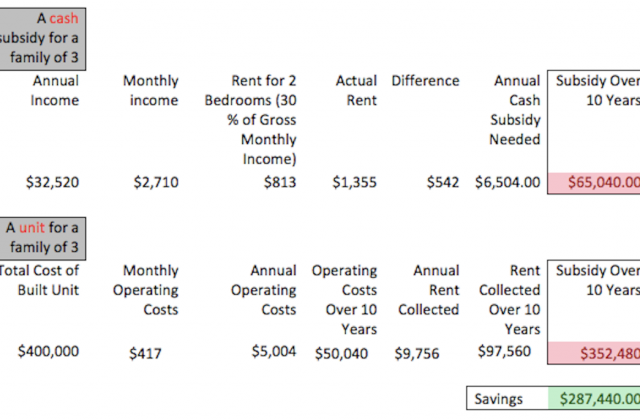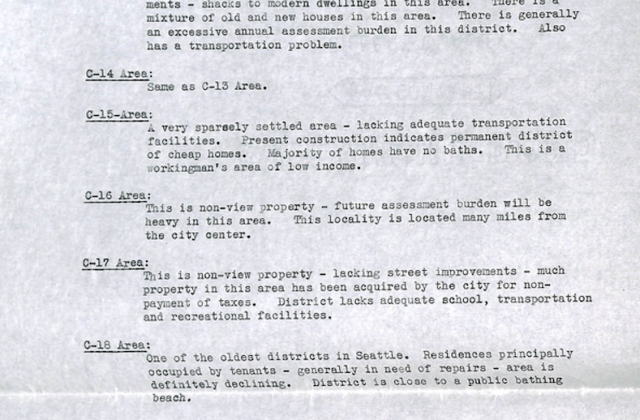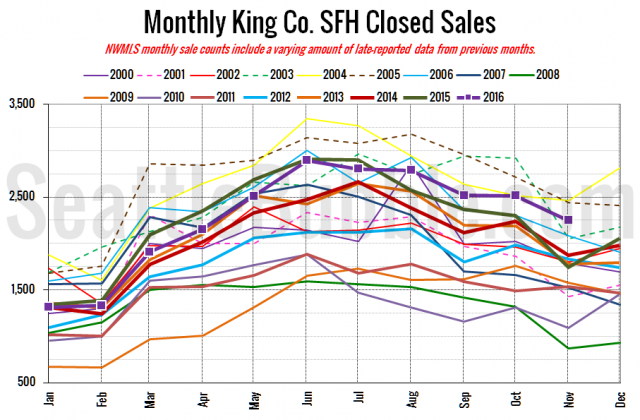Trends to Watch in 2017: Scrutiny of the Non-Profit Housing Industrial Complex
I wrote a post at Forbes in late November that sparked kind of a firestorm among people who make money from the financing and construction of non-profit subsidized housing. The post, “How Trump Might Drain the Low Income Housing Tax Credit Swamp,” did have a click batey headline I’ll admit. But it got a lot of attention, over 6000 people at least clicked on the post. And one list serve lit up with people worrying that the post would create, “a negative impression in a perilous environment.” I also had to correct a mistake I made implying that low income housing tax credits require paying prevailing wages; they don’t, but one syndicator couldn’t think of any project that does not end up paying the higher wages because of other money used to leverage tax credit equity. This year could be the year, though, when the media and State government starts asking, “Why is non-profit subsidized housing so expensive to build?”
I’ve already approached legislators about the idea of an audit and even, perhaps, prohibiting the use of Housing Trust Fund dollars in any jurisdiction that passes Mandatory Inclusionary Zoning (MIZ). I’ve had problems with the way we fund non-profit housing since I was working to get funding for a project I was working on. It isn’t that I think we shouldn’t have subsidies for housing. In fact, I think subsidies are essential and will always be needed to help families and households with fewer dollars to spend on everything, including housing. I’ve suggested that instead of laundering money wrung out of the production of market rate housing through expensive City bureaucracy the way MIZ does, we’d be better off making cash payments to households coming up short when they pay rent.
If the press and public knew just how inefficient our system of producing subsidized units I think they’d demand improvements of that system, and instead of fighting more scrutiny (as I am sure they will), non-profit housing builders should welcome the improvements that would come from an audit. And they should join forces with us to reduce regulatory hurdles that add the same costs to subsidized housing as to market rate housing. Instead, we have a broken and bent political process that is going to essentially extort money from market rate builders, a cost that will be carried by consumers in the end, to build a small number of enormously expensive subsidized units. I don’t use the word extortion lightly. Google defines extortion as “obtain[ing] (something) by force, threats, or other unfair means.”
Remember what the Mayor said about MIZ just about a year ago:
The heart of HALA is you don’t get to develop housing in this city, multifamily housing, unless you build affordable housing as part of it. That is the key piece to it. We have developed . . . .We have grown as a city, but we have not grown affordably. What we are saying is, if you are going to build a multifamily unit in an urban village, you are going to build affordable housing, or you are going to pay penalties that will go into a fund for building affordable housing.
This is all in service not of lowering overall housing prices, but handing the “penalties” to non-profit housing developers who have held the process hostage demanding more cash to put into their expensive projects. That isn’t fair, especially for renters and home buyers who will bear the burden of these costs in the form of higher housing prices. And as I’ve said before the means being used to take the money is through an illegal, unauthorized tax. I hope by a year from now we’re in a different place, working more collaboratively on using our subsidy dollars more efficiently and reduces costs for all builders of housing.
Trends to Watch in 2017: The Failure of Mandatory Inclusionary Zoning
You heard it here first: The Mayor and City Council’s scheme to shake down builders of market rate housing for fees and rent restricted housing (also known as Mandatory Inclusionary Zoning or MIZ) will collapse in 2017. Simply put, neighborhood opposition combined with growing disinterest from the non-profits who benefit from the cash wrung from builders will mean the Council will likely either back off, or add even more blatantly illegal and punitive measures to MIZ ensuring its demise in the courts.
The non-profit housing advocates at the Housing Development Consortium have been oddly quiet about neighborhood rezones, and the coalition between them and blood thirsty socialists will collapse as the socialists and angry neighbors demand more and more from MIZ in neighborhood rezones (e.g. 25 percent inclusion rates). When the so-called Grand Bargain was rolled out more than a year ago, it was touted as a deal between developers, housing advocates, and neighbors.
The problem of course is that there was only one market rate developer represented at the table, Vulcan. There was no neighborhood person, and certainly no socialists, especially not Councilmember Kshama Sawant. Everyone else at the table had a non-profit housing interest, including the chair of the Housing Affordability and Livability Agenda (HALA) Committee.
What the Bargain did is solve a intermediate political problem: how to make developers downtown and South Lake Union pay a cash penalty for building their projects, give the cash to non-profit developers, and call the whole thing a win for density and affordable housing. They should have stopped there, and limited the scheme to downtown and South Lake Union. That would have been hard enough. Last year Councilmember Sally Bagshaw put that deal in peril by pandering to wealthy residents of the Escala building, proposing a new tower spacing scheme downtown.
But City leaders overloaded their buffet plate and expanded the scheme citywide. This overreach is likely what will bring the whole thing down. At the time I wondered, “What makes the Council think that the same angry neighbors they just pandered to with a downzone in the low-rise would suddenly embrace an upzone just a year later?” Like most of the questions I ask of City leaders there was nothing but silence. Some people tried to explain that it was a start, at least we’d get the housing.
I explained back that even if the inclusionary aspect of the MIZ scheme “worked,” it would be because the prices would go up for everything else to pay for the rent restrictions. The smart ones would sort of just stop at that point. Others would argue that, “Well, the price of the land will go down in the exact amount of the costs and fees.” Umm, no it won’t. In fact, as I pointed out earlier, landowners now think they can ask more for the land because of the upzone.
And the press mostly hand waved and eye rolled their way through this whole thing, not out of ignorance or even lack of interest, but because it’s a complicated story. They dutifully reported the hearings and the passage of this piece and that piece and the debate over displacement in the U District, but there has never been a substantive and deep analysis of why and how this whole notion that we’d jack prices up on housing to collect cash to give to non-profits to build really expensive subsidized units was an “affordable housing” strategy. Too complicated.
I told someone yesterday that I feel like Michael Burry from The Big Short. I’m betting on something failing. It’s sad. And it’s been the most difficult thing I’ve ever done in my career. I told her, whatever I do next, I really want it to be building something good, something that will make life better rather than fighting against something that I know will make things worse. I’ll leave you with the closing from the film. If I’m right, and I know I am, the failure of MIZ won’t be about popping champagne bottles, it’ll be about picking up the pieces. Lots and lots of pieces.
Trends to Watch in 2017: An Upsurge of Identity Politics
Something to watch unfold this year in Seattle as we try to work on the housing shortage which is leading to higher prices, is an upsurge of identity politics associated with housing. As a person of color (or POC as we’re called) I am concerned about the growing role that race is taking in our efforts to deal with the obvious problem of not having enough housing choice in Seattle. And it seems that with the election of Donald Trump, this phenomenon is getting worse as local politicians try to make big statements locally to somehow fend off national trends. Lets look at some examples.
First, the selection of Rebecca Saldana as state senator. Saldana is a smart and dedicated advocate having worked for years for Puget Sound Sage, and organization that is largely supported by labor unions. Saldana’s group published a report a few years back about race, economics, and the effects of light rail on the Rainier Valley. I took strong exception to one conclusion that was in the report. Here’s what I wrote in Crosscut:
The [report’s] emphasis on proportion leads to this shocking statement in the report:
“Southeast Seattle neighborhoods should remain majority people of color.”
I say it’s shocking because what if a report was published that said this:
“Northeast Seattle neighborhoods should remain majority white people.”
I met later with Saldana who didn’t like the article I wrote and a follow up television interview I did. I told her that she simply must revise the report. The implications of the statement are problematic for a few reasons. First, how would such a policy be implemented. Would we seriously survey and census certain parts of the city and push for racial quotas? Second, why would we want to do such a thing? And even if we could figure out how to do this, what would be the benefit? Would we really want a codified racial segregation?
Saldana refused to promise to revise the statement into something resembling an actual policy statement rooted in some data. So there it remains, a clear advocacy for a higher ratio of people of color to white people in a Seattle neighborhood. And when I asked current City Councilmember Lorena Gonzalez to disavow this in a public forum, she flatly refused, instead saying, “no ethnic group should be reduced to a number.” I’m sure my face expressed puzzlement, and I said, “Isn’t that exactly what the Sage report is doing?” No answer.
Saldana (who added a diacritic “ñ” to her name at some point) was selected to finish the term of Pramilla Jaypal, who was elected to Congress, by the King County Council even though in the process at the democratic district level she came in second after a vote by the districts Precinct Committee Officers. And there wasn’t even any attempt to explain away why: it was because she is a person of color, and the top vote getter is a white man.
Second, the Seattle City Council has started to practice a form of red lining. Councilmember Lisa Herbold has successfully fought to impose higher fees in areas of the city that have high populations of people of color, immigrants, and who speak English as a second language (Herbold calls these, “low opportunity areas.” Imagine the stigma associated with that moniker). The reason for this is to protect them from displacement. As I pointed out in a post at Forbes, what the proposal really does is impose a huge disincentive to build housing in those neighborhoods exactly what the Federal Home Loan Bank did when it redlined areas to discourage investment in making housing loans in the 30s and 40s.
So while Seattleites are daily shocked by Donald Trump’s Twitter feed right downtown there are real reasons to be outraged. The city seems to be going deeper and deeper into a place where people of color are being named as the reason for doing really bad things, ironically, for neighborhoods where people of color live. I don’t know how we can stop this slide which is made worse because white people feel as though they can’t criticize this for fear of being called racist. It’s only a start, but I will keep bringing these issues up because I can and because somebody needs to point out that these policies would only make things worse for people who truly would benefit most by more housing opportunity.
Trends to Watch in 2017: Uncertainty in the Land Market Created by MIZ
Almost every forecast for single-family home prices and for apartment rents is indicating that prices will still be going up because of a lack of inventory. This means buildable land will also be more expensive. But I think a trend to watch will be growing uncertainty among both sellers of land and buyers created by the Seattle City Council’s slapdash approach to land use regulation and especially what they’re doing with Mandatory Inclusionary Zoning (MIZ). Sellers are going to be watching for opportunities to ask for more money, and buyers will be eying new rules and taxes to find discounts. With the Council going back and forth on how much to tax housing development with MIZ, a scheme that charges a tax on all new housing and adds small upzones, the lack of clarity is likely to draw out the purchasing process and thus the production of housing.
My prediction about this is based entirely on anecdotes I have been hearing lately from builders and people who buy and sell land for them. One person I talked to said one seller had the proposed upzone map for MIZ with his property circled. This was a reason for him to demand more money for the property since the City’s up zone would allow more housing to be built there. But the pushback is that the zoning changes are far off and they come with a tax that I’ve already shown will make building on the property more difficult and costly.
One argument prevalent at City Hall is that buyers will push harder on sellers to lower prices because the fees will lower the Residual Land Value (RLV) calculation. If you remember, RLV is how the City is testing the feasibility of MIZ and their last report agreed that fees will have a negative impact on financing. However, using the RLV method of testing feasibility implicitly relies on the idea that land prices will drop in exactly the amount as the fees and costs associated with building under the MIZ scheme. The exact opposite is happening in the market with sellers seeing the possible upzones as an incentive to sit tight and sell higher once the upzones pass.
The Council hasn’t even passed any MIZ upzones yet and already the market is feeling some tightening in supply of buildable land because sellers are holding out for more, not buyers walking away because they want to pay less. Either of these scenarios, however, means that the lot in question will stay what it is, under built, rather than turning into housing for more people. That means less supply and higher prices. Let’s hope that in 2017 we get smarter about housing economics and dispense with MIZ. It’s likely the proposal will be doing harm even before the upzones are implemented.
Featured image from Seattle Bubble.
What Is To Be Done?: Taking on 2017 and Beyond
Councilmember Tim Burgess’ announcement that he will not seek reelection to the Seattle City Council has sparked early conversation among people who build and operate housing about who we should support in 2017. My simple answer is no one, since it is very unlikely that a candidate will emerge that will truly represent our concerns and interests or help undo the damage that Burgess, his Council colleagues, and the Mayor have already done to the housing economy. Yes, it is true that almost anyone is better than Jon Grant, a growth opponent and champion of rent control. But what should we do in 2017 and beyond to help prevent Seattle from an irretrievable slide down the San Francisco Death Spiral? Here’s my first take.
Candidate Vetting
Outgoing Councilmember Tim Burgess is the textbook example of what I’d call a Wet Councilmember. The term comes from the sobriquet attached to Conservative politicians in the United Kingdom who were afraid to fully implement and follow the implications of the policies of Prime Minister Margaret Thatcher. These were politicians who publically opposed the Labor party’s blatant socialism, but wanted to maintain vast swaths of socialist policies because they didn’t truly believe in the alternatives. I also call Burgess wet because although he’s been hailed as a voice of moderation, he got soaked carrying Sawant’s water, voting for almost all her measures, including a resolution in favor of rent control.
Burgess took our money and voted against us again and again. I would implore the business and housing development and building community not to support someone unless it is clear that he or she is opposed to rent control, Mandatory Inclusionary Zoning (MIZ), and would promise to soften or repeal the myriad of so-called tenant rights legislation passed over the last year. Think about it for a minute. Any candidate who can’t take these positions publically is a Wet, and even though they might be nicer to us than Jon Grant (they might even smile and nod when we explain our business) he or she is still going to vote for terrible policy. That isn’t winning. We shouldn’t support a candidate that doesn’t support our work, period.
The Environment
Let’s face it the people of Seattle, the voters, hold views that are simply inconsistent with basic economic facts. If I were to take on my old job as campaign manager for a candidate, I’d advise anyone who wanted to the job to stay as far away from us as possible. In fact, I’d tell my candidate to support almost every one of Grant and Sawant’s ideas but without all the radical language. I’d urge my candidate to be the “reasonable one” and the “adult in the room,” but to support legislation that would attempt to micromanage the business of housing. If you want to win, I’d tell her, you simply must run as a social justice candidate on the side of single-family homeowners and renters and against business and housing developers.
I know. It’s frustrating. But we’ve picked up a really bad hand. And we have weak and ineffective leadership. A mob has formed made up of single-family homeowners who will see their equity rise with housing scarcity, social justice advocates who have confused the production of a few subsidized units with affordability (MIZ), and tenant advocates who base their advocacy on outlier cases of extreme disutility in the housing market. And nobody at City Hall is challenging the mob, only doing its bidding. Even a few leaders who would debate, oppose, and challenge the mob’s assumptions would make a huge difference, but that politician doesn’t exist and wouldn’t likely get elected even if she did.
Here’s a quick map of what we need to be doing in 2017. We must:
- Be very careful to vet candidates and be unified in not supporting anyone who is a Wet (see above);
- Pay close attention to what candidates say in public and hold then accountable in our publications and reflect their views back to our members;
- Challenge the non-profit housing industry that has taken the moral high ground in the housing debate in Seattle by exposing their inefficiencies; and
- Fund Smart Growth Seattle to expand it’s ability to do effective research and communication
Preparing for the Future: Research, Communication, and Intellectual Infrastructure
I would advise you to take a few minutes (about 8) and watch the story of the resurgence of the market economy in the United Kingdom. Did you watch? OK. It tells the story of the change from a deeply socialist economy to a market based economy. It took time and wasn’t easy. Advent is over, and we now are in Christmas. But Advent is about the waiting for a savior. A prophet emerges, in the Christian story it is John the Baptist, and for market economics it is Keith Joseph. He paved the way for Margaret Thatcher who was the candidate who had the strength of principles to change a country and its economy.
I know. It’s obscure. But my point is that we need to build infrastructure in Seattle for the future for when we do find candidates and support in the electorate for a change. We also need to change the views of the electorate, but that will take years not months and it won’t happen over the course of one election. In the example I cite from the United Kingdom, things didn’t change over night and there were setbacks along the way. But all along that way, there were people working to get the message down, to build that message so that a candidate has solid and positive responses to questions about housing, not affirmations of the mob.
In the clip I linked to one of my intellectual heroes, Fredrich Von Hayek, says
When I was a young man only a very old man believed in the free market . . . I’ve lived long enough to see that the young people believe in it again.
I intend to live that long. And if we invest in the research and the messaging, we’ll be ready.






